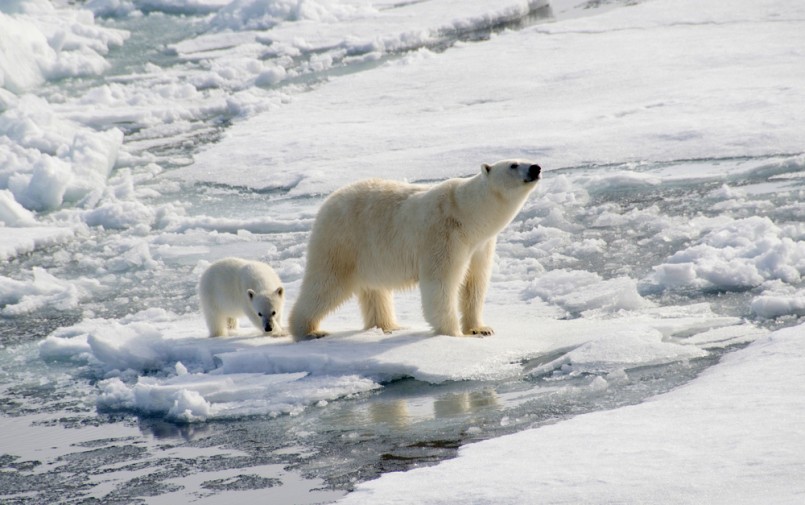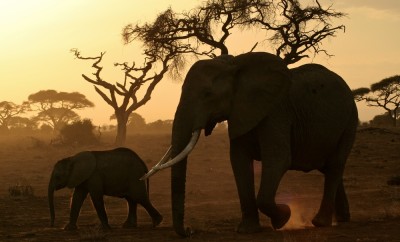Environment
Environmental Change Is Causing Unusual Instances Of Cannibalism

Image: Shutterstock/Christopher Wood
Environmental Change Is Causing Unusual Instances Of Cannibalism
Although cannibalism isn’t unusual in the wild world of nature, scientists believe it may have entered new terrain with the behaviors of some species. From spiders and shrimp to lions and salamanders, eating one’s own isn’t uncommon, especially in times of parasitic invasion and diminished prey. However, increased occurrences previously unseen in some animal groups may signal a critical change in environmental conditions.
Teams of arctic scientists have long studied polar bears, but only since the 1980’s has the phenomenon of cannibalism among polar bears been specifically followed. Recent discoveries revealed males eating their cubs on film for the first time while being observed near the Canadian Baffin Island in 2015. The film, while difficult to watch, was shared by the Lindblad Expedition trip via National Geographic’s Explorer, and held consistency with other scientific accounts of such behavior which had been documented, but previously un-filmed. While not exceptional behavior for the species, the occurrence spurred heightened inquiry as to potentially new implications, drawing both concern and questions from interested groups.
Typically polar bear males have eaten their young when their usual prey, seals, are scarce. This normally occurs in autumn months when seals are frequently out to sea and unavailable as a food source. However, concerns have arisen that shrinking sea ice in the Arctic may be contributing to the phenomenon, since 2015 marked the lowest sea ice maximum extent measured in thirty years. Since sea ice is the main hunting terrain of polar bears upon their resting seal prey, its shrinkage is of particular concern for Arctic scientists.
While males have eaten their young on occasion, they don’t usually go for females as prey. This behavior appears to be changing, though, as 2014 marked an incident where biologists in the Alaskan Beaufort Sea observed a male tracking and eating a pregnant female in her den, a behavior which had never before been observed. Such events are increasing according to BBC News Photojournalist Jenny E. Ross, who asserts that extended periods of time spent trapped ashore without prey as a result of diminishing sea ice is a likely cause. A 2011 study conducted by Ross and co-author Ian Stirling revealed sea ice shrinkage directly effects the number of seals as an available food source and a resulting increase in interspecific predation may occur.
However, it should be noted that cannibalism does not always occur due to a lack of prey. Some species, like the African lion, find males eating young after taking over a pride from another male. This action, according to Alison Dunn, an evolutionary biologist at University of Leeds, causes the females to go into estrus again and thus allows the new males to impregnate them and fill the pride with their own offspring. Other species, such as sand tiger sharks, cane toads, prairie dogs, hippopotamuses, sloth bears, scorpions, nematode worms, beetles, perch, cichlids, crickets, owls, snakes and various spiders, have also cannibalized their young, each other, and even occasionally their own mothers.
Geologist David Soulsby, author of Animal Cannibalism: The Dark Side of Evolution, reports walleye fish often eat one another tail-first, even in groups of up to four, sometimes connected in a chain. Soulsby also asserts that some species develop two forms of larva, a normal and a cannibal form. The cannibals develop differently, with wider mouths and jutting lower jaws, and thus hold the upper hand in times of food scarcity.
Cannibalism can also be linked to other causes, such as increased stressors in regard to relocation of or changes in the animals’ original environment. Crab spiders eat their own mothers as larvae, as do certain worms, scorpions, butterfly caterpillars and other insects. Some shrimp increasingly cannibalize one another in response to parasites invading their species, often eating up to double the number of interspecies hosts than might normally occur. Female twisted wing parasites follow suit by living their entire lives inside their hosts, eventually being eaten alive by her own young after laying eggs inside themselves, a phenomenon publicized by entomologist Katy Prudic of University of Arizona. Sexual cannibalism isn’t unusual either, with prominent examples of black widows and praying mantises.
Whether environmentally induced or otherwise, cannibalism occurs within a multitude of species. Changes in frequency due to environmental stressors or events causing prey scarcity or hunting/living area diminishment, however, are of particular concern to scientists at this time. If human behavior is contributing to even a small portion of it, appropriate acknowledgment and a subsequent change in lifestyle is most definitely warranted. It is one thing to observe a species eating one another; its quite another to lose the species altogether.





0 comments